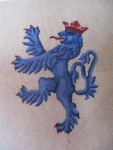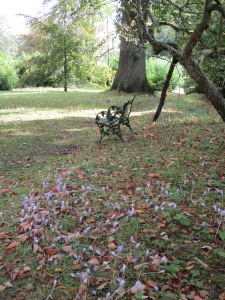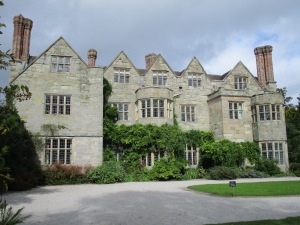This blog entry is somewhat delayed due to a guidebook deficiency. When asked, one of the helpful volunteers at the house was highly apologetic and said that they have been waiting for a reprint of the guidebook for months. What’s more, they have also run out of the free hand-outs, so the visitor is left very much in the dark. With my blogging requirements, I couldn’t really afford to be in the dark (metaphorically at least, this was actually one of the lighter properties I’d been to all week!), so I photographed a lot of the information sheets in the house and then ordered a second-hand guidebook the second I got home.
I have had issues like this before, having had to order a second-hand guide to Ormesby Hall online, while the staff at the Needles batteries gave me an old one from their office free of charge. That’s around £15 the Trust has missed out on through poor planning and that’s not counting any of the other visitors who might have bought a guide and couldn’t. If it is that difficult or expensive to reprint the full colour guides, what’s wrong with offering plainer text versions for a fraction of the cost?
Anyway, it’s not Benthall’s fault if the powers-that-be are a little negligent with their printing responsibilities so now I’ve got the complaining out of my system, I’ll move on.
 Somewhat remarkably, the Benthall family can positively trace their association with the village of Benthall back to the early 1100s and it is believed to go back several further generations before this. It is thought that the existing Tudor hall was built in two stages in the 1530s and 1580s, with the general style of the visible architecture most likely dating to the later of these periods, covering up much of the earlier build. Some of the more dramatic decorations in the house, including the over-mantels and plasterwork in the Entrance Hall, Dining Room and Drawing Room, date to Lawrence Benthall’s time in around 1630. He was married to Katherine Cassy and the decorative work incorporates the arms of the Benthalls (a two-tailed lion rampant) combined with those of the Cassy family. Genealogy is clearly important to the Benthalls as the small Linen Room upstairs is also lined with the coats of arms of the Benthalls and the many families with which they have intermarried.
Somewhat remarkably, the Benthall family can positively trace their association with the village of Benthall back to the early 1100s and it is believed to go back several further generations before this. It is thought that the existing Tudor hall was built in two stages in the 1530s and 1580s, with the general style of the visible architecture most likely dating to the later of these periods, covering up much of the earlier build. Some of the more dramatic decorations in the house, including the over-mantels and plasterwork in the Entrance Hall, Dining Room and Drawing Room, date to Lawrence Benthall’s time in around 1630. He was married to Katherine Cassy and the decorative work incorporates the arms of the Benthalls (a two-tailed lion rampant) combined with those of the Cassy family. Genealogy is clearly important to the Benthalls as the small Linen Room upstairs is also lined with the coats of arms of the Benthalls and the many families with which they have intermarried.
During the Civil War, the Royalist house was taken over and occupied by a garrison of Parliamentarians and was the site of a skirmish in 1645 when Royalist forces tried to retake the house. It is thought that the Drawing Room bore the brunt of this assault and that some of the panelling in the room has been replaced with inferior wood, leading to its being covered over with paint. The Dining Room panelling and over-mantel were similarly covered until the 1930s when the white paint was removed to reveal the original wood (although pale patches on the more ornate wood carving show how difficult this was).
The Shropshire Benthall line ran out in the 1840s, although there were still separate branches of the family based in Essex and Devon. Edward Benthall of the Devon branch tried to buy the Hall and estate when it came up for sale in 1843 but was outbid by Lord Forester and so began almost 100 years in which no Benthall lived there. An interesting aside for me is that the Essex branch of the family established businesses under the Bentalls name and I am very familiar with the Bentalls department store in Kingston-upon-Thames, founded in the 1860s by Frank Bentall from Essex. I haven’t been able to establish if he is part of the Essex Benthalls descended from William Benthall, the Tudor builder of Benthall Hall, but it is entirely possible (if anyone knows for sure, do get in touch!)
Under Lord Forester’s ownership, the property was tenanted from the 1840s to the 1930s. The most notable of the tenants were brothers George and Arthur Maw, who ran the tileworks Maw & Co in nearby Jackfield and who replaced the stone flagged floor in the Entrance Hall with an intricate tiled design, using it to impress potential customers. This very Victorian flooring was not really in keeping with the house’s architecture so has since been covered over with wooden floorboards, but the Trust has opened up a section so you can see what lies beneath. Sadly, it seems that the floorboarding job was not done with any great care and there is significant damage to the tiles.
 The tenants of Benthall Hall were also extremely influential when it comes to the gardens. George Maw was an enthusiastic botanist and introduced many varieties of crocus to the gardens (the autumn ones looked very pretty under the trees) and even wrote a book entitled ‘The Genus Crocus’. The next tenant, Robert Bateman, who lived there from 1890 to 1906, was the son of James Bateman who created the famous gardens at Biddulph Grange (now NT but not yet visited for this blog), and was clearly green-fingered himself. It was he and his wife who laid out the terraces and rockeries and are believed to have built the dovecote.
The tenants of Benthall Hall were also extremely influential when it comes to the gardens. George Maw was an enthusiastic botanist and introduced many varieties of crocus to the gardens (the autumn ones looked very pretty under the trees) and even wrote a book entitled ‘The Genus Crocus’. The next tenant, Robert Bateman, who lived there from 1890 to 1906, was the son of James Bateman who created the famous gardens at Biddulph Grange (now NT but not yet visited for this blog), and was clearly green-fingered himself. It was he and his wife who laid out the terraces and rockeries and are believed to have built the dovecote.
In 1918, a Benthall returned to the house, with Reverend Charles Benthall moving in as a tenant, but it was in 1934 that the house came back on the market and returned to family ownership. Trust properties usually have a ‘story’ of the season that they concentrate on to make repeat visits more interesting and this year’s story at Benthall revolves around Mary Clementina Dale, née Benthall, who raised the £6,000 needed to buy the property before it went up for auction. She and her husband James Floyer Dale changed their name back to Benthall when they moved in.
 It was Mary Clementina who left the house to the National Trust in 1960, helped by a couple of her cousins, Sir Edward and Sir Paul Benthall, who supplied a healthy endowment. Sir Paul and his wife were the first familial tenants under National Trust ownership, followed by their second son James and his wife, then their first son Richard and his wife and now their son Edward and his wife who spend several months a year at Benthall when the visitors have left. There is clear evidence of modern occupation in the first floor rooms, with a television and digital radio sitting alongside more period pieces. It must feel very special to come back to a place in which your ancestors first settled almost 1,000 years earlier.
It was Mary Clementina who left the house to the National Trust in 1960, helped by a couple of her cousins, Sir Edward and Sir Paul Benthall, who supplied a healthy endowment. Sir Paul and his wife were the first familial tenants under National Trust ownership, followed by their second son James and his wife, then their first son Richard and his wife and now their son Edward and his wife who spend several months a year at Benthall when the visitors have left. There is clear evidence of modern occupation in the first floor rooms, with a television and digital radio sitting alongside more period pieces. It must feel very special to come back to a place in which your ancestors first settled almost 1,000 years earlier.
NB: Benthall Hall represents something of a landmark for me as it was number 166 on my list, meaning that I now have only 99 left. This is still a significant number but being down into double figures feels like an achievement. I’m looking forward to what else the Trust has to offer me over the next few years.
Highlights: Plasterwork and wood carving
Refreshments: Hot chocolate and toasted teacake
Purchase(s): ‘Rough Music’ by Patrick Gale from the second-hand bookshop
Companion(s): None
NT Connections: Robert Bateman, tenant at Benthall Hall, was the son of James Bateman, creator of Biddulph Grange Gardens

